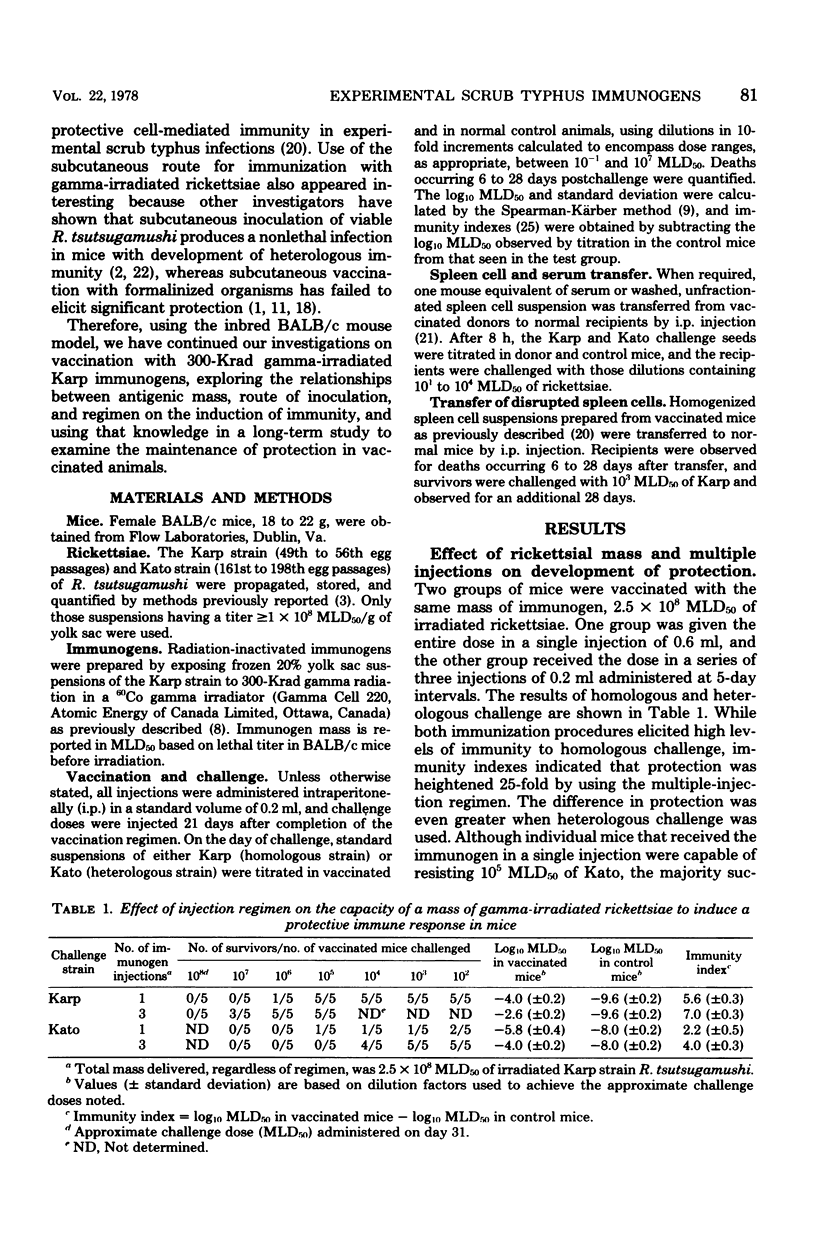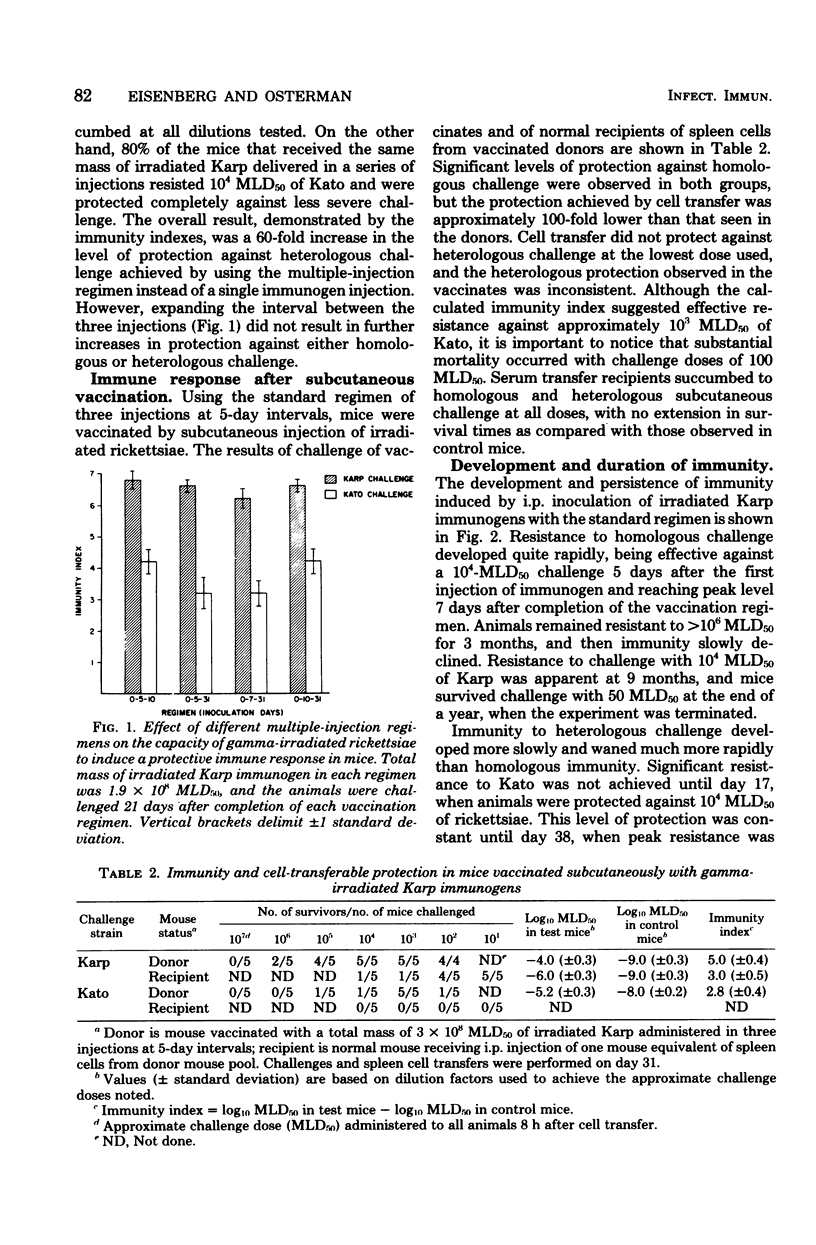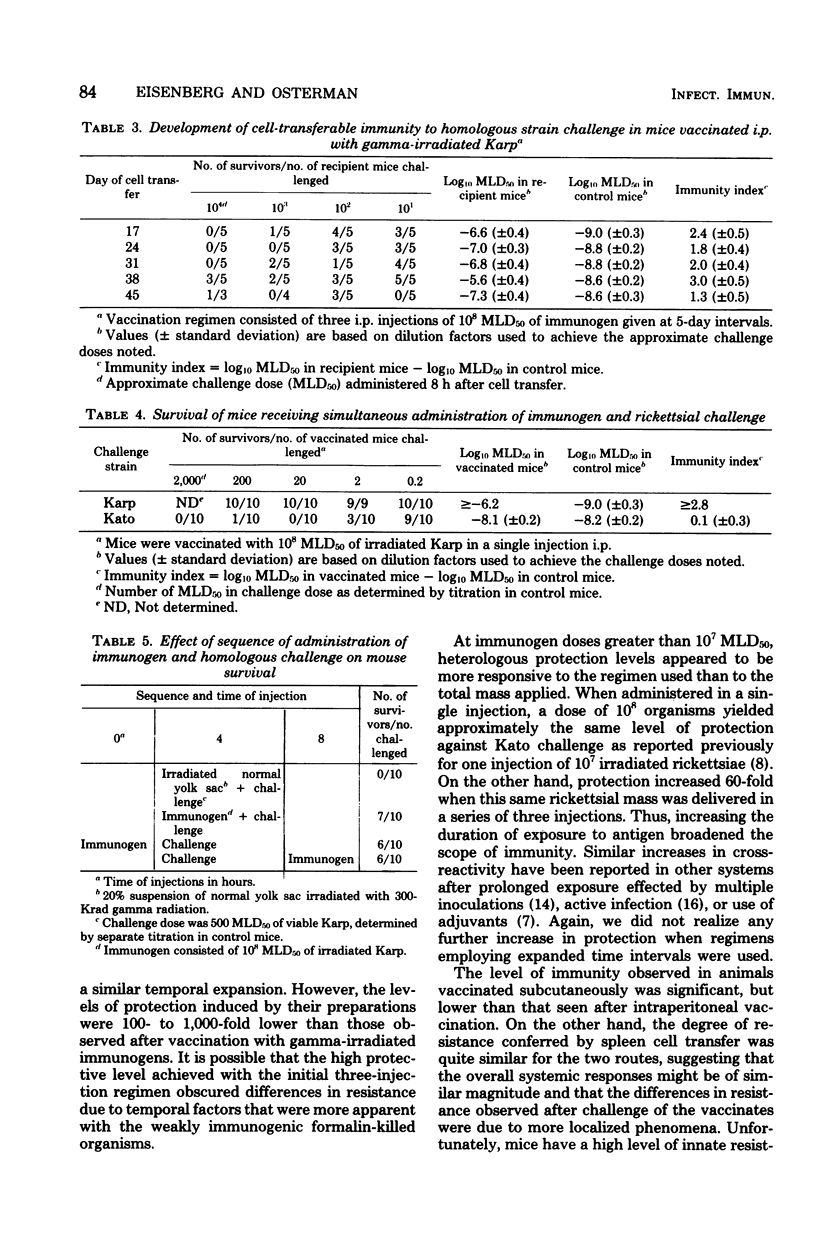Abstract
The development and duration of immunity to lethal scrub typhus infection was studied in BALB/c mice vaccinated with gamma-irradiated Rickettsia tsutsugamushi, strain Karp. One intraperitoneal injection containing approximately 108 50% mouse lethal doses (MLD50) of irradiated organisms elicited an immune response protective against challenge with 105 MLD50 of viable Karp. The same mass of immunogen given in three injections at 5-day intervals increased homologous (Karp strain) protection 25-fold and heterologous (Kato strain) protection 60-fold. Further temporal expansion of the immunization regimen did not increase protection. Subcutaneous vaccination provided significant, but lower, levels of protection than were achieved by intraperitoneal immunization, but the levels of cell-transferable immunity elicited by the two routes were approximately the same. Immunologically specific protection after intraperitoneal vaccination developed rapidly enough to provide resistance against simultaneous challenge with 200 MLD50 of Karp. Homologous immunity was protective against a 106-MLD50 challenge 7 days after completion of the three-injection regimen, remained at that level for 3 months, dropped to 104 MLD50 by 9 months, and was effective against a 50-MLD50 Karp challenge at 12 months. Protection against heterologous challenge was first observed on day 17 and peaked on day 38, when the mice resisted a 105-MLD50 Kato challenge. Thereafter, heterologous protection waned rapidly and was not significant at 6 months.
Full text
PDF






Selected References
These references are in PubMed. This may not be the complete list of references from this article.
- COHN Z. A., BOZEMAN F. M., CAMPBELL J. M., HUMPHRIES J. W., SAWYER T. K. Study on growth of Rickettsia. V. Penetration of Rickettsia tsutsugamushi into mammalian cells in vitro. J Exp Med. 1959 Mar 1;109(3):271–292. doi: 10.1084/jem.109.3.271. [DOI] [PMC free article] [PubMed] [Google Scholar]
- Catanzaro P. J., Shirai A., Hilderbrandt P. K., Osterman J. V. Host defenses in experimental scrub typhus: histopathological correlates. Infect Immun. 1976 Mar;13(3):861–875. doi: 10.1128/iai.13.3.861-875.1976. [DOI] [PMC free article] [PubMed] [Google Scholar]
- EDSALL G., BANTON H. J., WHEELER R. E. The antigenicity of single, graded doses of purified diphtheria toxoid in man. Am J Hyg. 1951 May;53(3):283–295. doi: 10.1093/oxfordjournals.aje.a119454. [DOI] [PubMed] [Google Scholar]
- EDSALL G. Immunization. Annu Rev Microbiol. 1955;9:347–368. doi: 10.1146/annurev.mi.09.100155.002023. [DOI] [PubMed] [Google Scholar]
- EISEN H. N., SISKIND G. W. VARIATIONS IN AFFINITIES OF ANTIBODIES DURING THE IMMUNE RESPONSE. Biochemistry. 1964 Jul;3:996–1008. doi: 10.1021/bi00895a027. [DOI] [PubMed] [Google Scholar]
- Eisenberg G. H., Jr, Osterman J. V. Experimental scrub typhus immunogens: gamma-irradiated and formalinized rickettsiae. Infect Immun. 1977 Jan;15(1):124–131. doi: 10.1128/iai.15.1.124-131.1977. [DOI] [PMC free article] [PubMed] [Google Scholar]
- GAULD R. L., GOODNER K. Epidemic typhus vaccine; antibody response to a single dose among persons previously vaccinated. U S Armed Forces Med J. 1951 Sep;2(9):1311–1315. [PubMed] [Google Scholar]
- Groves M. G., Osterman J. V. Host defenses in experimental scrub typhus: genetics of natural resistance to infection. Infect Immun. 1978 Feb;19(2):583–588. doi: 10.1128/iai.19.2.583-588.1978. [DOI] [PMC free article] [PubMed] [Google Scholar]
- KUWATA T. Analysis of immunity in experimental Tsutsugamushi disease. J Immunol. 1952 Feb;68(2):115–120. [PubMed] [Google Scholar]
- MACKANESS G. B. THE IMMUNOLOGICAL BASIS OF ACQUIRED CELLULAR RESISTANCE. J Exp Med. 1964 Jul 1;120:105–120. doi: 10.1084/jem.120.1.105. [DOI] [PMC free article] [PubMed] [Google Scholar]
- Murray E. S., Kmet J., Jung M., O'Connor J. M., Gaon J. A. Antibody response to a typhus vaccine booster in individuals previously sensitized by either a typhus infection or a single injection of typhus vaccine. J Hyg Epidemiol Microbiol Immunol. 1968;12(1):7–13. [PubMed] [Google Scholar]
- SMADEL J. E., LEY H. L., Jr, DIERCKS F. H., PATERSON P. Y., WISSEMAN C. L., Jr, TRAUB R. Immunization against scrub typhus: duration of immunity in volunteers following combined living vaccine and chemoprophylaxis. Am J Trop Med Hyg. 1952 Jan;1(1):87–99. doi: 10.4269/ajtmh.1952.1.87. [DOI] [PubMed] [Google Scholar]
- SMADEL J. E., LEY H. L., Jr, DIERCKS F. H., TRAUB R. Immunity in scrub typhus: resistance to induced reinfection. AMA Arch Pathol. 1950 Dec;50(6):847–861. [PubMed] [Google Scholar]
- Shirai A., Catanzaro P. J., Eisenberg G. H., Jr, Osterman J. V. Host defenses in experimental scrub typhus: effect of chloramphenicol. Infect Immun. 1977 Nov;18(2):324–329. doi: 10.1128/iai.18.2.324-329.1977. [DOI] [PMC free article] [PubMed] [Google Scholar]
- Shirai A., Catanzaro P. J., Phillips S. M., Osterman J. V. Host defenses in experimental scrub typhus: role of cellular immunity in heterologous protection. Infect Immun. 1976 Jul;14(1):39–46. doi: 10.1128/iai.14.1.39-46.1976. [DOI] [PMC free article] [PubMed] [Google Scholar]


